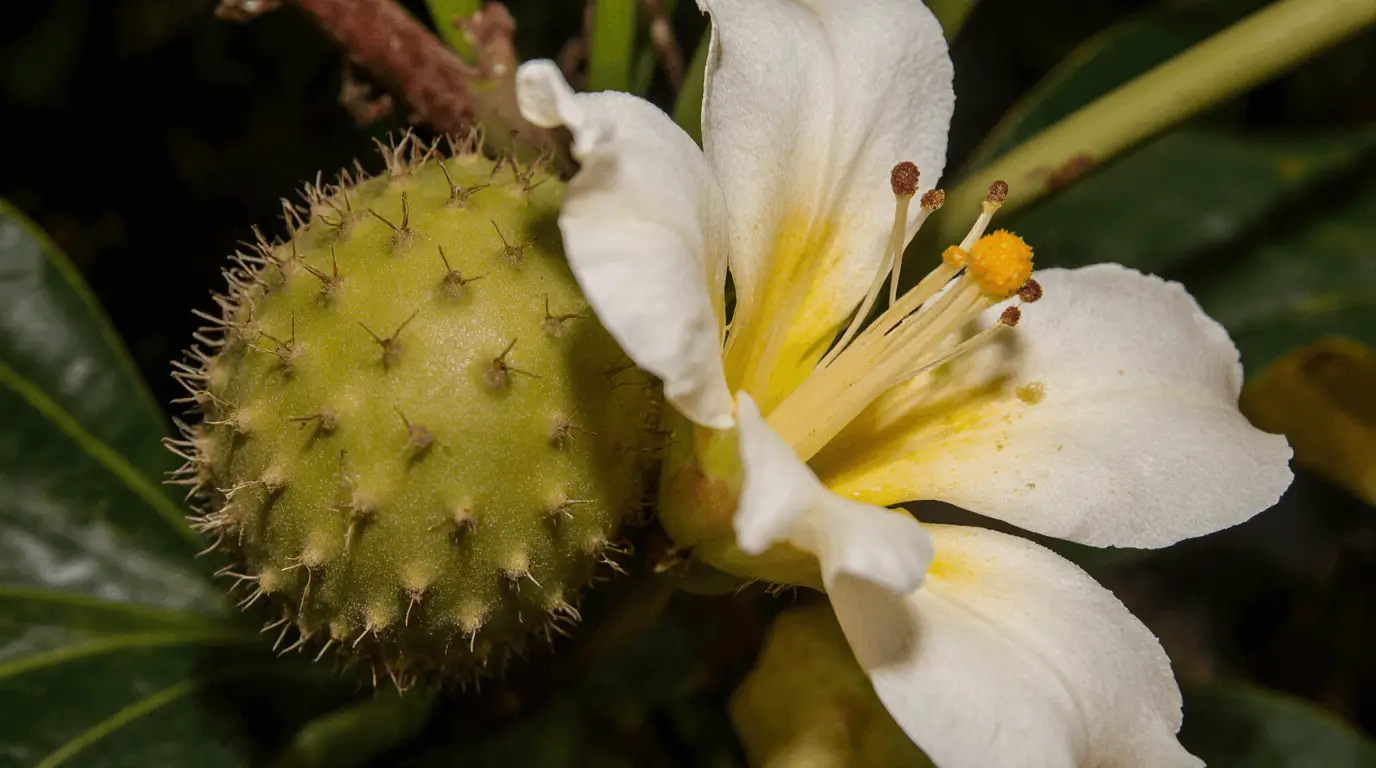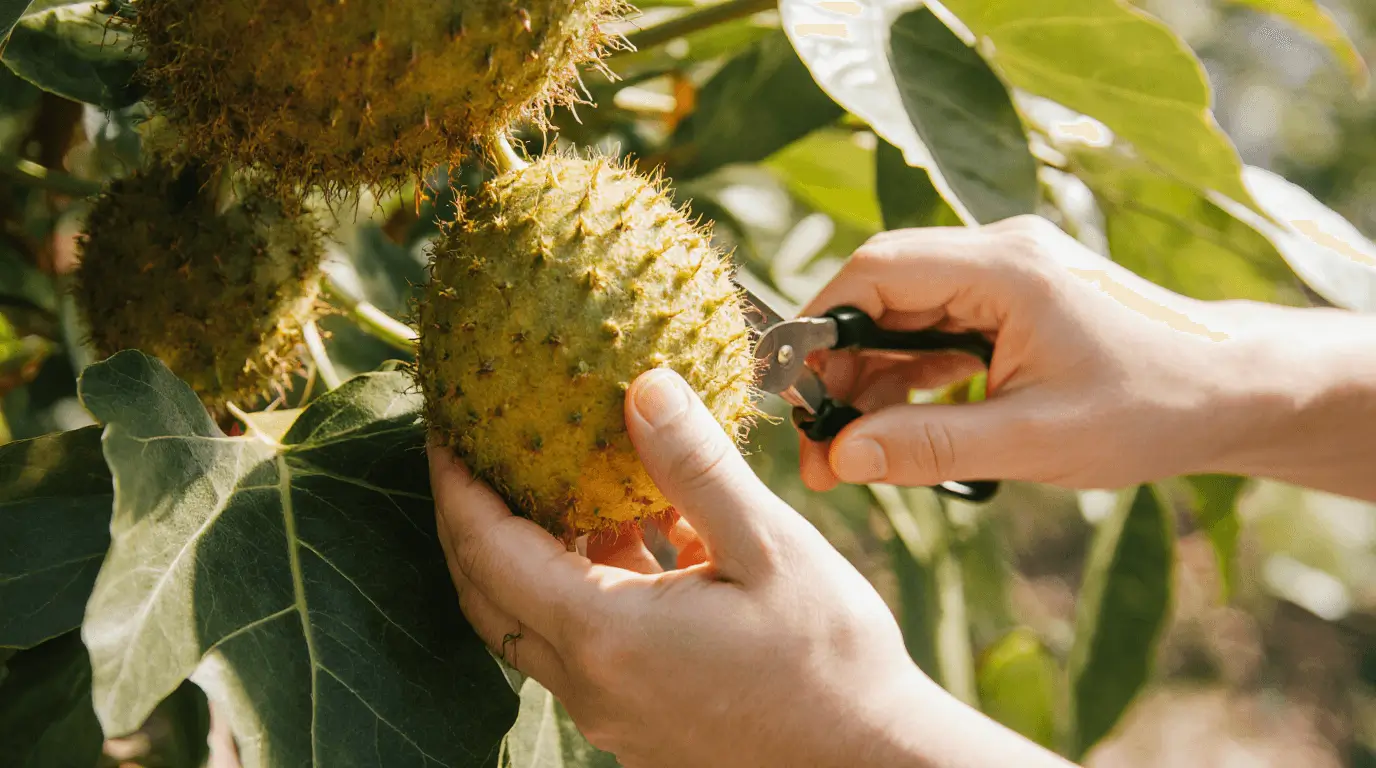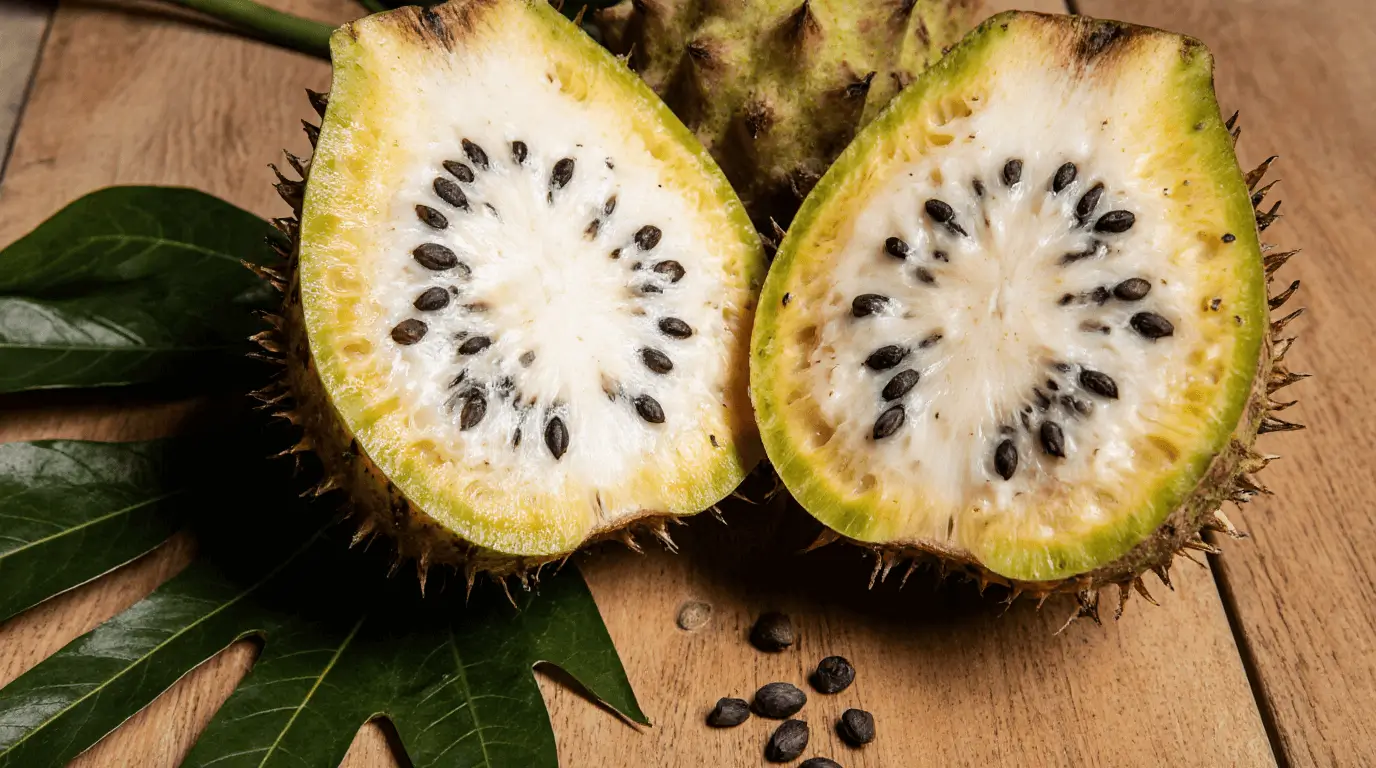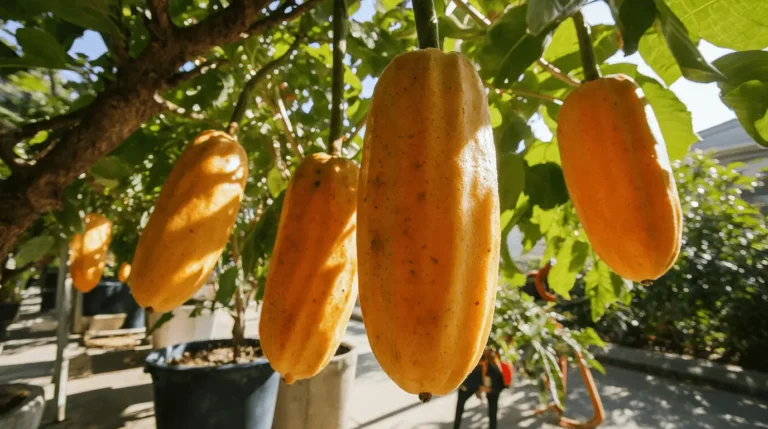When I first started growing my soursop tree, also known as Graviola or Guanábana, I realized how much of a tropical wonder it truly is. This tropical tree loves warm weather, rich soil, and steady care. Many home growers often find it a mystery when their tree doesn’t bear fruit, but the secret lies in proper cultivation, patience, and attention to tree care. Soursop trees thrive best in a tropical climate, whether planted in a garden, orchard, or even kept potted on a patio. The guide to success starts with providing enough sunlight, soursop fertilizer, and moisture balance to encourage fruiting and healthy fruit production.
Once your soursop fruit begins to form, you’ll notice its spiky green fruit developing a smooth texture as ripeness approaches. The sweet pulp and tangy pulp inside signal that fruit maturity and fruit ripening are near. A gentle squeeze can help you tell when it’s perfectly ripe. To harvest correctly, handle the exotic fruit with care to keep its unique flavor, nutrients, and antioxidants intact. After picking, you can preserve or enjoy it fresh for its amazing health benefits, especially its reputation for helping with ailments like cancer, diabetes, and inflammation. Growing soursop is more than home gardening — it’s a beautiful experience in tropical gardening, blending horticulture, plant care, and the joy of natural healing right in your own backyard.
Read Also: The Sweet Reward of Growing Your Own Soursop Tree

Why Isn’t My Soursop Tree Producing Fruit?
When your soursop or tropical tree struggles with fruiting, understanding the main reasons can help restore its growth and overall productivity.
- Check pollination — lack of natural pollinators or missed hand-pollination often reduces fruit set and yield.
- Improve soil quality — poor soil conditions can limit nutrients and harm development in your gardening or cultivation setup.
- Provide enough sunlight — inadequate sunlight affects photosynthesis, weakening blossoms, flowers, and fruiting stages.
- Maintain proper watering — both improper watering and low moisture levels disrupt the balance needed for healthy growth.
- Consider tree immaturity — young trees often take time to reach full maturity and begin producing fruit steadily with proper care, fertilization, and consistent horticulture practices suited to their environment.
Read Also: Troubleshoot Common Fruiting Issues

Step 1: Boosting Pollination
Why Pollination Matters
In nature, soursop trees depend on beetles as their natural pollinators, but in many backyard gardens, these helpers are often missing. Proper pollination is vital for fruiting, healthy growth, and higher fruit yield, especially in a tropical environment where every step in the pollination process supports successful fertilization and reproduction of the tropical tree.
Hand Pollination: Your Best Bet
- Try hand-pollinating during the blooming season using a small brush or cotton swab to mimic cross-pollination found in floral biology.
- In the early morning, collect pollen from a male flower — look for yellow grains as a sign of maturity.
- Gently transfer it to a female flower with a visible central ovary, ensuring contact for effective manual pollination and better fruiting results.
- Practice this method with care and the right timing; consistent plant care, good horticulture techniques, and proper garden management will greatly improve your fruit yield and overall growth.
How Can You Tell if a Soursop Flower is Male or Female?
In my experience with soursop, recognizing male flowers and female flowers depends on careful observation and timing. The male flowers usually open first and release their pollen, while the female flowers follow and receive it during the blooming or flowering stage. Understanding this gender difference and the floral structure is key to successful pollination, fertilization, and steady fruit formation in your tropical tree.
Step 2: Soil and Location
For healthy soursop trees, the right soil and location play a big role in steady growth and cultivation success.
- Choose well-draining soil that’s rich in nutrients with an ideal pH of 6.0–6.5 to maintain fertility and moisture balance.
- Avoid clay-heavy or waterlogged ground — poor drainage affects root health, structure, and long-term horticulture results.
- Add compost and organic matter to enrich the soil composition, support aeration, and create a natural soil mix suited to tropical conditions and sustainable gardening.
Step 3: Give It Plenty of Sun
How much sunlight do soursop trees really need for healthy growth and fruiting?
From my experience, soursop trees love full sun and thrive best when they receive direct sunlight for about 6–8 hours of daily light. In a tropical environment, proper exposure and optimal lighting support photosynthesis, provide energy, and maintain ideal temperature for steady growth and strong fruit production. Make sure your tropical tree isn’t blocked by taller trees, walls, or shadows, as too much shade can reduce brightness, weaken plant health, and limit fruiting. Good positioning, balanced sunlight intensity, and thoughtful horticulture practices in your garden help achieve the right light requirement and keep your soursop tree flourishing naturally.
Step 4: Master the Watering Routine
When it comes to caring for a soursop tree, maintaining the right watering habits ensures strong growth and healthy root health. Every tropical tree thrives on balance, so understanding the basics of its irrigation and watering schedule is key to long-term cultivation success.
- Deep water your plant about 2–3 times per week, depending on the climate and weather. Allow the top 2 inches of soil to dry out between watering to prevent overwatering and promote proper drainage and moisture balance.
- Keep consistent hydration by monitoring soil moisture levels. Avoid underwatering, and focus on water retention through good plant care, proper environment management, and smart horticulture practices suited to tropical conditions in your garden.
Signs You’re Doing It Wrong
- Yellow leaves usually mean overwatering, which affects root health and prevents proper drainage.
- Crispy or curled leaves often point to underwatering, showing your soursop tree isn’t getting enough hydration or moisture balance to stay healthy.
Step 5: Fertilize Smartly
What Is the Best Fertilizer for Soursop Trees?
For a soursop tree to thrive, choose an organic fertilizer rich in phosphorus and potassium. These key nutrients encourage strong blooming, healthy fruit development, and balanced plant nutrition throughout the growth cycle. You can also mix in compost or organic matter to boost soil enrichment, improve soil fertility, and support long-term plant health and root development in your tropical tree and garden.
Fertilizing Schedule
From my experience in horticulture and cultivation, a consistent fertilizing schedule makes a big difference. Feed your tree every 6–8 weeks during the growing season, using moderate amounts of fertilizer for best results. Avoid too much nitrogen, as it leads to leafy growth instead of fruit. Focus on maintaining nutrient balance, proper application timing, and using natural feed methods for sustainable gardening that enhances yield and supports steady fertilization over time.
Step 6: Regular Pruning
Why You Should Prune
From my experience, regular pruning keeps the tree healthy and helps it breathe better. It also prevents disease, improves plant health, and directs energy toward fruiting branches instead of wasted growth. Proper branch management supports strong structure and balanced cultivation in every soursop tree.
How and When to Prune
- Prune once a year to maintain good airflow and proper sunlight penetration throughout the garden and tropical tree.
- Remove dead branches, damaged branches, and eliminate suckers growing from the base to allow steady renewal and better disease control.
- Thin out crowded areas through careful shaping and trimming — this seasonal maintenance ensures smooth growth, keeps horticulture efficient, and encourages continuous plant health during seasonal care.
Prune Regularly
Regular pruning keeps your tree healthy by improving air circulation and allowing it to focus energy on better fruit production. From my experience in horticulture and cultivation, proper branch management brings lasting growth, renewal, and overall plant health in your garden or tropical tree setup.
- Prune dead branches and crowded branches annually to support balanced structure and steady development.
- Remove suckers from the base of the soursop tree to maintain smooth airflow, encourage strong fruiting, and aid in disease prevention.
- Use light trimming and gentle shaping as part of seasonal maintenance and seasonal care to improve sunlight exposure and support healthy growth and fruit production.
Step 7: Consider the Tree’s Age
How long does it take for a soursop tree to bear fruit?
From my experience in horticulture and cultivation, a soursop tree grown from seed-grown methods usually takes about 3–5 years to bear fruit, while grafted trees can start fruiting in as little as 2 years. The age and maturity stage of your tropical tree play a big role in fruit production and overall yield.
If your young tree hasn’t started producing yet, don’t worry—patience is part of the natural process. The tree growth rate depends on the environment, tropical conditions, and proper planting method used in your garden. With consistent development, balanced plant health, and care during each growing season, your tree will eventually reach full maturity and become a reliable fruit-bearing companion in your tropical
Step 8: Watch the Weather
Protect from Wind and Cold
In changing weather and climate, your soursop tree needs extra protection from strong wind and cold. From my own garden experience, I’ve learned that chilly nights, frost, and sudden seasonal change can slow growth and damage flowers and fruiting. To protect your tropical tree, plant it near a windbreak or provide shelter to reduce harsh airflow. Wrapping the trunk during winter helps maintain temperature, improves stability, and builds resilience against tough outdoor conditions and other natural elements that affect plant health, cultivation, and overall environment.
How to Know When Soursop Is Ripe
Visual Clues
When checking your soursop for ripening, pay close attention to its visual clues and overall appearance.
- The skin color changes from dark green to light green, and a soft yellow tint may start to appear.
- The spikes soften and begin to flatten, showing clear readiness for harvesting.
- Gently press fruit — it should yield slightly without feeling mushy, a sign of proper maturity, softness, and fruit development.
How Long After Pollination?
Through years of observation in horticulture and cultivation, I’ve seen that tropical fruit like soursop usually ripens 4–5 months after flowering. Marking the bloom date helps with accurate tracking of the time frame and ensures you harvest your tropical tree’s fruit at the perfect stage of natural process, environment, and plant health balance.

Harvesting Tips
When it comes to harvesting your soursop, the right timing and technique make all the difference in maintaining fruit quality and yield. In my orchard, I’ve learned that understanding maturity, ripeness, and careful handling keeps the tropical fruit in its best condition and supports long-term plant health and cultivation.
Here are a few useful tips to follow:
- Always use garden shears to cut the fruit with the stem intact—this prevents bruising and ensures proper handling.
- Never pull the delicate fruit from the tree, as it can cause damage or make it overripen and fall before its time.
- Practice gentle handling and smart damage prevention as part of your harvesting method and seasonal care to maintain quality and protect your tropical tree and environment.
Read Also: Gardening & Plant Care Guide for Thriving Plants
Troubleshooting Common Problems
Even a healthy soursop tree can face fruiting issues if certain conditions aren’t right, but with the right care routine, you can bring it back to balance.
- Check the pollination process and sunlight exposure — lack of either can cause your tree to not produce fruit.
- Evaluate soil quality and fertilizer type, ensuring proper fertilization for consistent growth and plant health.
- Look for yellowing leaves, which may result from overwatering or nutrient deficiency that needs deficiency correction.
- If dropping flowers appear, it could mean insufficient pollination or sudden weather changes affecting your tropical tree.
- Watch for leaf spots or fungal infection, and treat early using neem oil or copper fungicide as part of good disease management and pest control.
Read Also: Tree Insect Management
Too much overwatering can reduce water balance and affect environment stability.
Proper treatment and prevention methods ensure lasting cultivation success.
Balanced horticulture practices maintain a healthy garden and higher fruiting rates.
A strong natural remedy routine supports recovery from stress and promotes resilience.
Stable tree age, nutrients, and climate control improve your tropical tree’s performance.
Bonus Tips for Success
Here are a few proven tips I’ve learned through years of horticulture and cultivation to help your soursop trees thrive naturally in tropical conditions and stay in perfect balance with the environment.
Start by using mulch around the base to keep moisture steady and improve soil quality. It also enriches the ground and supports water retention for long-lasting growth and healthy development. Regularly apply compost—it feeds essential soil microbes, boosts root health, and adds organic matter for better soil health and sustainability. Avoid overcrowding and maintain good plant spacing to ensure proper airflow between other trees, supporting a stronger root system and overall plant care. Regular maintenance in your garden keeps your tropical tree thriving and encourages natural harmony in its ecosystem.
The Sweet Reward of Growing Your Own Soursop Tree
Growing a soursop tree is truly a journey of patience, care, and dedication that leads to a beautiful payoff. Watching the first flower bloom and later tasting your own homegrown fruit brings unmatched satisfaction and fulfillment. This tropical tree, when nurtured with love and consistent gardening, reflects the natural process of growth, maturity, and fruiting that connects you deeply with your environment. Through steady cultivation and mindful horticulture, your garden becomes a source of wellness, beauty, and lasting enjoyment. With each harvest, you’ll witness success, greater yield, and the true sweet reward of your effort — a symbol of tropical abundance and the joy of planting that continues year after year.
Conclusion
Growing a soursop tree is more than just a gardening project—it’s an experience of patience, growth, and deep connection with nature. From planting to harvest, each stage rewards you with the joy of watching your tropical tree flourish and produce delicious homegrown fruit. With the right care, love, and consistent cultivation, you’ll enjoy the true sweet reward of your effort—beautiful fruit, rich wellness, and lifelong fulfillment that grows year after year.
Read Also: Tropical Fruit Trees: Grow Exotic Paradise at Home

FAQs
- How long does it take for a soursop tree to produce fruit?
A soursop tree typically starts fruiting within 3 to 5 years if grown from seed, while grafted trees may bear fruit in as little as 2 years. - How can I tell when my soursop fruit is ripe?
Watch for skin color changes from dark to light green, and gently press the fruit—it should slightly yield without feeling too soft. - What kind of soil does a soursop tree prefer?
It grows best in well-draining, nutrient-rich soil with good moisture balance and a pH between 6.0 and 6.5. - How much sunlight does a soursop tree need?
A tropical tree like soursop thrives in full sun, ideally receiving 6–8 hours of direct sunlight daily for healthy growth and fruit production. - How can I care for my soursop tree year-round?
Maintain regular watering, seasonal pruning, balanced fertilization, and protect the tree from cold weather to ensure strong yield and lasting plant health.




